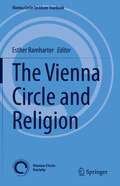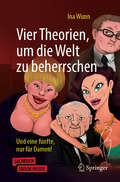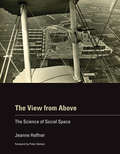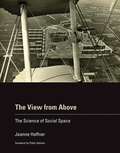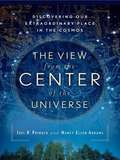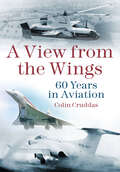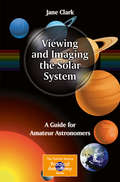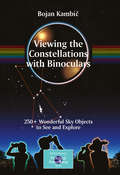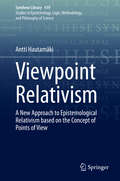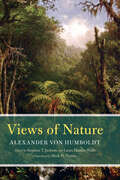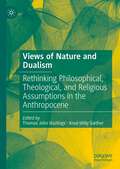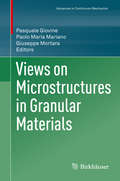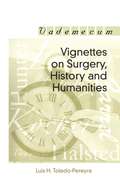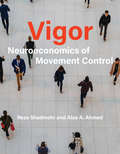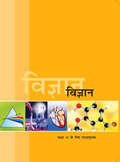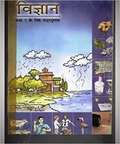- Table View
- List View
The Vienna Circle and Religion (Vienna Circle Institute Yearbook #25)
by Esther RamharterThis book is the first systematic and historical account of the Vienna Circle that deals with the relation of logical empiricists with religion as well as theology. Given the standard image of the Vienna Circle as a strong anti-metaphysical group and non-religious philosophical and intellectual movement, this book draws a surprising conclusion, namely, that several members of the famous Moritz Schlick-Circle - e.g., the left wing with Rudolf Carnap, Otto Neurath, Philipp Frank, Edgar Zilsel, but also Schlick himself - dealt with the dualisms of faith/ belief and knowledge, religion and science despite, or because of their non-cognitivist commitment to the values of Enlightenment. One remarkable exception was the philosopher and Rabbi Joseph Schächter, who wrote explicitly on religion and philosophy after the linguistic turn. The book also covers another puzzling figure: the famous logician Kurt Gödel, who wrote on theology and the ontological proof of God in his so far unpublished notebooks. The book opens up new perspectives on the Vienna Circle with its internal philosophical and political pluralism and is of value to philosophers, historians and anybody who is interested in the relation between science and religion.
Vier Theorien, um die Welt zu beherrschen: Und eine fünfte, nur für Damen!
by Ina WunnWie kommt man gesellschaftlich ganz nach oben? Man kämpft um Macht und Anerkennung und möchte um jeden Preis Aufmerksamkeit erregen. Dabei stellt sich die Frage: Ist das wirklich so einfach und wenn ja, wo fange ich an?Gibt es einen Dresscode, der mich als Mitglied der herrschenden Klasse auszeichnet? Hilft es gar, wenn Frauen Miniröcke und tiefe Ausschnitte tragen? Läuft es etwa darauf hinaus, dass sich meine egoistische Überlebensmaschine mit ebenso egoistischen und möglichst erfolgreichen Genen zusammentut? Geht es in letzter Konsequenz nur um Paarung, um die Alphastellung und damit um einen bevorzugten Platz auf der Mating-Liste?Über all das haben sich Generationen von Biologen, Verhaltensforschern und zuletzt auch Gesellschaftswissenschaftlern Gedanken gemacht. Aber erst, wenn man vier bahnbrechende und eigentlich ganz simple Theorien (egoistisches Gen, Ritual, System und Habitus) in einen inhaltlichen Zusammenhang bringt, lässt sich das Rätsel um das große Spiel von Liebe und Macht, von Schönheit und Herrschaft, von Aufstieg und Fall durchschauen. Und sollten wir die mit Beispielen aus der Welt der Reichen und Schönen angereicherte Lektüre als Lehrstück auffassen, steht unserem gesellschaftlichen Aufstieg in die herrschende Klasse nichts mehr im Wege!
The View from Above: The Science of Social Space
by Jeanne HaffnerThe role of aerial photography in the evolution of the concept of social space”and its impact on French urban planning in the mid-twentieth century.In mid-twentieth century France, the term “social space” (l'espace social)—the idea that spatial form and social life are inextricably linked—emerged in a variety of social science disciplines. Taken up by the French New Left, it also came to inform the practice of urban planning. In The View from Above, Jeanne Haffner traces the evolution of the science of social space from the interwar period to the 1970s, illuminating in particular the role of aerial photography in this new way of conceptualizing socio-spatial relations. As early as the 1930s, the view from above served for Marcel Griaule and other anthropologists as a means of connecting the social and the spatial. Just a few decades later, the Marxist urban sociologist Henri Lefebvre called the perspective enabled by aerial photography—a technique closely associated with the French colonial state and military—“the space of state control.” Lefebvre and others nevertheless used the notion of social space to recast the problem of massive modernist housing projects (grands ensembles) to encompass the modern suburb (banlieue) itself—a critique that has contemporary resonance in light of the banlieue riots of 2005 and 2007. Haffner shows how such “views” permitted new ways of conceptualizing the old problem of housing to emerge. She also points to broader issues, including the influence of the colonies on the metropole, the application of sociological expertise to the study of the built environment, and the development of a spatially oriented critique of capitalism.
The View from Above
by Jeanne Haffner Peter GalisonIn mid-twentieth century France, the term "social space" ( l'espace social) -- the idea that spatial form and social life are inextricably linked -- emerged in a variety of social science disciplines. Taken up by the French New Left, it also came to inform the practice of urban planning. In The View from Above, Jeanne Haffner traces the evolution of the science of social space from the interwar period to the 1970s, illuminating in particular the role of aerial photography in this new way of conceptualizing socio-spatial relations. As early as the 1930s, the view from above served for Marcel Griaule and other anthropologists as a means of connecting the social and the spatial. Just a few decades later, the Marxist urban sociologist Henri Lefebvre called the perspective enabled by aerial photography -- a technique closely associated with the French colonial state and military -- "the space of state control." Lefebvre and others nevertheless used the notion of social space to recast the problem of massive modernist housing projects (grands ensembles) to encompass the modern suburb (banlieue) itself -- a critique that has contemporary resonance in light of the banlieue riots of 2005 and 2007. Haffner shows how such "views" permitted new ways of conceptualizing the old problem of housing to emerge. She also points to broader issues, including the influence of the colonies on the metropole, the application of sociological expertise to the study of the built environment, and the development of a spatially oriented critique of capitalism.
The View From the Center of the Universe: Discovering Our Extraordinary Place in the Cosmos
by Nancy Ellen Abrams Joel R. PrimackIn this strikingly original book, a world-renowned cosmologist and an innovative writer of the history and philosophy of science uncover an astonishing truth: Humans actually are central to the universe.<P><P> What does this mean for our culture and our personal lives? The answer is revolutionary: a science-based cosmology that allows us to understand the universe as a whole and our extraordinary place in it. .
A View from the Wings: 60 Years in British Aviation
by Colin CruddasMany books have been produced which detail the lives and thoughts of famous individuals. A View from the Wings is unique, recalling a wartime boyhood in which aircraft flying constantly overhead played a large part. This experience led to a lifetime career in the aviation industry both in the UK and overseas such as the US and South Africa. Mixed with events of a more personal nature often coated with whimsical humour, the author has evocatively captured the rise and demise of Britain’s aircraft industry in the post-war period. In setting out to be non-technical, A View from the Wings will appeal to those whose memories embrace the sound barrier-breaking years and the leap of faith and technology that saw Concorde defeat the Americans in the race to produce a practical supersonic airliner. All too often political procurement and technical failures have made for dramatic headlines and these too are subjected to much critical comments. Think of the critically acclaimed Empire of the Clouds (Faber and Faber, 2010), but instead of a boyhood observer, the author was an active part of the British aviation industry in its former prime and eventual implosion.
Viewing and Imaging the Solar System
by Jane ClarkViewing and Imaging the Solar System: A Guide for Amateur Astronomers is for those who want to develop their ability to observe and image Solar System objects, including the planets and moons, the Sun, and comets and asteroids. They might be beginners, or they may have already owned and used an astronomical telescope for a year or more. Newcomers are almost always wowed by sights such as the rings of Saturn and the moons of Jupiter, but have little idea how to find these objects for themselves (with the obvious exceptions of the Sun and Moon). They also need guidance about what equipment, besides a telescope, they will need. This book is written by an expert on the Solar System, who has had a lot of experience with outreach programs, which teach others how to make the most of relatively simple and low-cost equipment. That does not mean that this book is not for serious amateurs. On the contrary, it is designed to show amateur astronomers, in a relatively light-hearted--and math-free way--how to become serious.
Viewing the Constellations with Binoculars
by Bojan KambicViewing the Constellations with Binoculars is a complete guide to practical astronomy, written for beginners, intermediate-level astronomers, and even people who have not yet turned their gaze to the night sky. The required observing equipment to get the full value from this book is no more than a pair of regular 10 x 50 binoculars, but even more can be seen with a small astronomical telescope. This comprehensive introduction to astronomy and practical observing is far more than a guide to what can be seen in the night sky through binoculars. It introduces the reader to some basic (and some not-so-basic) astronomical concepts, and discusses the stars and their evolution, the planets, nebulae, and distant galaxies. There is a guide to selecting and using binoculars for astronomy, as well, as a 'getting ready to observe' section containing invaluable practical hints and tips. The second part of the book is an extraordinarily complete atlas and guide to the night sky down to 30º N (covering all the USA and Europe). It is illustrated with superb and sometimes beautiful amateur astronomical photographs, detailed maps (down to 5th magnitude), descriptions, and data on all astronomical objects of interest.
Viewpoint Relativism: A New Approach to Epistemological Relativism based on the Concept of Points of View (Synthese Library #419)
by Antti HautamäkiThis book offers new insights into truth, knowledge, and reality. It details a unique approach to epistemological relativism based on the concept of points of view. In a point of view, an aspect represents an object for a subject. By applying this concept of points of view, the author develops a consistent and adequate form of relativism, called viewpoint relativism, according to which epistemic questions like “Is X true (or justified or existing)” are viewpoint-dependent. The monograph examines central issues related to epistemological relativism. It analyzes major arguments pro and con from different opinions. The author presents the arguments of well-known philosophers. These include such thinkers as Paul Boghossian, John Dewey, Nelson Goodman, Martin Kusch, C.I. Lewis, John MacFarlane, Hilary Putnam, W.V.O. Quine, Richard Rorty, John Searle, and Ludwig Wittgenstein. In the process, the author deconstructs the standard account of correspondence theory of truth. Viewpoint relativism is a moderate relativism, which is not subjected to standard criticism of extreme relativism. This book argues that knowledge creation presupposes openness to different points of view and their comparison. It also explores the broader implications of viewpoint relativism into current debate about truth in society. The author defends a critical relativism, which accepts pluralism but is critical against all points of view. In the conclusion, he explores the relevance of viewpoint relativism to democracy by showing that the main threat of modern democratic society is not pluralism but absolutism and fundamentalism.
Views of Nature
by Laura Dassow Walls Alexander Von Humboldt translated by Mark W. Person edited by Stephen T. JacksonPurchase of this book includes free trial access to www. million-books. com where you can read more than a million books for free. This is an OCR edition with typos. Excerpt from book: Modern views on the mountain systems of the two American peninsulas. Chains, which have a direction from S. W. to N. E. , in Brazil and in the Atlantic portion of the United States of North America. Depression of the Province of Chiquitos; ridges as watermarks between the Guapor6 and Aguapehi in 15 and 17 south lat. , and between the fluvial districts of the Orinoco and Eio Negro in 2 and 3 north lat. ?pp. 29-31. Continuation of the Andes-chain north of the isthmus of PanamS through the territory of the Aztecs, (where the Popocatepetl, recently ascended by Capt. Stone, rises to an altitude of 17,720 feet, ) and through the Crane and Rocky Mountains. Valuable scientific investigations of Capt. Fremont. The greatest barometric levelling ever accomplished, representing a profile of the ground over 28 of longitude. Culminating point of the route from the coast of the Atlantic to the South Sea. The South Pass southward of the Wind-River Mountains. Swelling of the ground in the Great Basin. Long disputed existence of Lake Timpanogos. Coast-chain, Maritime Alps, Sierra Nevada of California. Volcanic eruptions. Cataracts of the Columbia River?pp. 31-38. General considerations on the contrast between the configuration of the territorial spaces, presented by the two diverging coast-chains, east and west of the central chain, called the Rocky Mountains. Hypsometric constitution of the Eastern Lowland, which is only from 400 to somewhat more than 600 feet above the level of the sea, and of the arid uninhabited plateau of the Great Basin, from 5000 to more than 6000 feet high. Sources of the Mississippi in Lake Istaca according to Nicollet, whose labours are most meritorious. Native land of the Bisons; their ancient domestication in Northern Mexico asserted by Gomara?pp. 38-42. Retrospectiv. .
Views of Nature and Dualism: Rethinking Philosophical, Theological, and Religious Assumptions in the Anthropocene
by Thomas John Hastings Knut-Willy SætherIn the face of the anthropogenic threats to the singular planetary habitat we share with other human beings and non-human species, humanities scholars feel a renewed sense of urgency 1) to acknowledge the ways our species has funded particular histories of environmental exploitation, alienation, and collapse, 2) to unpack inherited assumptions that impact our views of nature and interspecies relations, and 3) to suggest ways of thinking and acting that seek to repair the damage and promote mutual flourishing for all of earth inhabitants. This volume brings together scholars in philosophy, theology, and religion who take up this urgent ethical task from a broad range of perspectives and locations.
Views on Microstructures in Granular Materials (Advances in Mechanics and Mathematics #44)
by Pasquale Giovine Paolo Maria Mariano Giuseppe MortaraThis contributed volume provides an up-to-date overview of the mechanics of granular materials, ranging from sparse media to soils. With chapters exploring state-of-the-art theoretical, experimental, and applied trends in the study of granular matter in various states, readers will be motivated to learn about the current challenges and potential avenues of exploration in this active area of research. Including a variety of perspectives, this volume will be a valuable reference for audiences in a number of fields. Specific topics covered include:X-ray tomography techniques for analyzing sandEvaluation of effective stress in unsaturated soilsHyper-plasticityWave propagation in granular systemsPartly saturated porous mediaMulti-scale approaches to the dynamics of sparse mediaViews on Microstructures in Granular Materials is an ideal resource for PhD students and researchers in applied mathematics, solid-state physics, civil engineering, and mechanical engineering.
Vignettes on Surgery, History and Humanities
by Luis Horacio Toledo-PereyraThis book introduces writings on the history and philosophy of surgery that previously appeared in the Journal of Investigative Surgery. It attempts to reach students of history in general and those interested in the history and philosophy of surgery in particular.
Vigor: Neuroeconomics of Movement Control
by Reza Shadmehr Alaa A. AhmedAn examination of the link between the vigor with which we move and the value that the brain assigns to the goal of the movement.Why do we reflexively run toward people we love, but only walk toward others? In Vigor, Reza Shadmehr and Alaa Ahmed examine the link between how the brain assigns value to things and how it controls our movements. They find that brain regions thought to be principally involved in decision making also affect movement vigor--and that brain regions thought to be principally responsible for movement also bias patterns of decision making.
Vigyan
by National Council Of Educational Research TrainingThis book prescribed by central board of secondary education, India for the students of class 6th subject science, studying through Hindi medium. This accessible version of the book doesn't leave any part of the book. The book is handy companion of the school and university students desiring to read facts in interesting way. NCERT books are must read for aspirants of competitive and job related examinations in India.
Vigyan
by National Council Of Educational Research TrainingThis book prescribed by central board of secondary education, India for the students of class 7th subject Science, studying through Hindi medium. This accessible version of the book doesn’t leave any part of the book. The book is handy companion of the school and university students desiring to read facts in interesting way. NCERT books are must read for aspirants of competitive and job related examinations in India.
Vigyan
by National Council Of Educational Research TrainingThis book prescribed by central board of secondary education, India for the students of class 8th subject Science, studying through Hindi medium. This accessible version of the book doesn’t leave any part of the book. The book is handy companion of the school and university students desiring to read facts in interesting way. NCERT books are must read for aspirants of competitive and job related examinations in India.
Vigyan aur Praudyogiki bhag-2 class 10 - Maharashtra Board: विज्ञान और प्रौद्योगिकी भाग-२ १०वीं कक्षा - महाराष्ट्र बोर्ड
by Maharashtra Rajya Pathyapustak Nirmiti Va Abhysakram Sanshodhan Mandal Pune‘विज्ञान और प्रौद्योगिकी – भाग 2’ दसवीं कक्षा की पाठ्यपुस्तक है, जिसमें आनुवांशिकता, उत्क्रांति, कोशिका विज्ञान, जैव प्रौद्योगिकी, पर्यावरण संरक्षण, ऊर्जा स्रोत, सामाजिक स्वास्थ्य और आपदा प्रबंधन जैसे महत्वपूर्ण विषयों को शामिल किया गया है। पुस्तक का उद्देश्य विद्यार्थियों में वैज्ञानिक दृष्टिकोण विकसित करना, प्रयोगात्मक गतिविधियों के माध्यम से विज्ञान को समझना और उसके व्यावहारिक उपयोगों से अवगत कराना है। इसमें आनुवंशिक परिवर्तन, सजीवों की जीवन प्रक्रियाएँ, पर्यावरणीय चुनौतियाँ, हरित ऊर्जा और जैविक विविधता पर विशेष ध्यान दिया गया है। विभिन्न अध्यायों में वैज्ञानिक अवधारणाओं को सरल भाषा में समझाया गया है और प्रश्नोत्तरी, प्रयोग तथा गतिविधियों को शामिल किया गया है ताकि छात्र न केवल पढ़ें बल्कि उसे व्यवहारिक रूप से समझ सकें। यह पुस्तक विद्यार्थियों को विज्ञान के प्रति रुचि बढ़ाने, तार्किक सोच विकसित करने और उनके बौद्धिक विकास में सहायक होती है।
Vigyan class 10 - Himachal Pradesh Board: विज्ञान कक्षा १० - हिमाचल प्रदेश बोर्ड
by Himachal Pradesh Board of School Education - Dharamshalaहिमाचल प्रदेश स्कूल शिक्षा बोर्ड, धर्मशाला द्वारा प्रकाशित कक्षा 10 के लिए "विज्ञान" का डिजिटल संस्करण, 2013 से 2022 तक की विभिन्न संस्करणों और पुनर्मुद्रितियों को शामिल करता है। इसका सारांश पाठ्यक्रम और शिक्षण प्रक्रिया के माध्यम से शिक्षकों और छात्रों के बीच एक सेतु के रूप में काम करता है। यह मूल्यांकन, संबोधन, और अच्छी तरह से प्रस्तुत सामग्री की महत्वता पर जोर देता है। रासायनिक अभिक्रियाएँ एवं समीकरण, अम्ल, क्षारक एवं लवण, धातु एवं अधातु, कार्बन एवं उसके यौगिक, तत्वों का आवर्त वर्गीकरण, जैव प्रक्रम, नियंत्रण एवं समन्वय, जीव जनन कैसे करते हैं, आनुवंशिकता एवं जैव विकास, प्रकाश-परावर्तन तथा अपवर्तन, मानव नेत्र तथा रंगबिरंगा संसार, विद्युत, विद्युत धारा के चुंबकीय प्रभाव, ऊर्जा के स्रोत, हमारा पर्यावरण और प्राकृतिक संसाधनों का संपोषित प्रबंधन। इसमें मानक पाठ्यक्रम के विषय शामिल हैं जैसे रासायनिक प्रतिक्रियाएं और समीकरण, धातु और अधातु, अम्ल, क्षार और लवण, कार्बन, आवर्त सारणी, जीवन प्रक्रियाएं, प्रजनन, आनुवंशिकता, प्रकाश, बिजली, मानव आंख, ऊर्जा, चुंबकत्व, पर्यावरण और संसाधन प्रबंधन। सीखने को आसान बनाने के लिए, किताबें चित्रों से सुसज्जित हैं जो छात्रों को स्पष्ट विचार बताती हैं। इसी तरह, पुस्तक में दिए गए उदाहरण अच्छी तरह से वर्णित हैं और उत्पन्न होने वाले किसी भी भ्रम को दूर करने में मदद करते हैं। यह पुस्तक हल किए गए और अनसुलझे प्रश्नों के साथ भी आती है ताकि छात्र स्वयं का परीक्षण कर सकें और अपने कौशल में सुधार कर सकें।
Vigyan class 10 - NCERT - 23: विज्ञान १०वीं कक्षा - एनसीईआरटी - २३
by Rashtriy Shaikshik Anusandhan Aur Prashikshan Parishadविज्ञान कक्षा 10वीं का राष्ट्रीय शैक्षिक अनुसंधान और प्रशिक्षण परिषद् ने पुस्तक हिंदी भाषा में प्रकाशित किया गया है, विज्ञान की इस पाठ्यपुस्तक में, जहाँ कहीं संभव हुआ है, प्रासंगिक सामाजिक सरोकारों को शामिल करने का एक सजग एवं सार्थक प्रयास किया गया है। विशेष आवश्यकता वाले समूह, लिंग भेदभाव, ऊर्जा और पर्यावरण संबंधी मुद्दों को इस पुस्तक में सहजता से समाहित किया गया है। इस पुस्तक के माध्यम से विद्यार्थियों को प्रबंधन संबंधित कुछ सरोकारों (उदाहरणार्थ, संपोषणीय विकास) पर परिचर्चा करने की प्रेरणा भी मिलेगी ताकि वे इनसे संबंधित सभी तथ्यों का वैज्ञानिक विश्लेषण करने के पश्चात स्वयं निर्णय ले सकें। इस पुस्तक की कुछ विशेषताएँ इसके प्रभाव को एक विस्तृत आयाम देती हैं। प्रत्येक अध्याय की भूमिका दैनिक जीवन से संबंधित उदाहरणों के साथ दी गई है तथा यथासंभव रूप से विद्यार्थियों द्वारा किए जा सकने वाले क्रियाकलापों को भी समाहित किया गया है।
Vigyan class 6 - NCERT - 23: विज्ञान ६वीं कक्षा - एनसीईआरटी - २३
by Rashtriy Shaikshik Anusandhan Aur Prashikshan Parishadविज्ञान ६वीं कक्षा इस पाठ्यपुस्तक में भोजन के घटक, वस्तुओं के समूह बनाना, पदार्थों का पृथक्करण, पौधों को जानिए, शरीर में गति, सजीव- विशेषताएँ एवं आवास, गति एवं दूरियों का मापन, प्रकाश-छायाएँ एवं परावर्तन, विद्युत् तथा परिपथ, चुंबकों द्वारा मनोरंजन और हमारे चारों ओर वायु के बारे में एक संक्षिप्त विचार मिलता है। 6 वीं कक्षा के छात्रों के लिए बनाया गया, इस पुस्तक में उन सभी विषयों को शामिल किया गया है, जिन्हें केंद्रीय माध्यमिक शिक्षा बोर्ड द्वारा उल्लिखित किया गया है।
Vigyan class 7 - NCERT - 23: विज्ञान ७वीं कक्षा - एनसीईआरटी - २३
by Rashtriy Shaikshik Anusandhan Aur Prashikshan Parishadविज्ञान कक्षा 7 के लिए यह पाठ्यपुस्तक युवा दिमागों को स्पष्ट समझ रखने में मदद करेगी कि पोषक तत्व क्या हैं और वे पौधों और जानवरों में क्यों महत्वपूर्ण हैं। छात्रों को एसिड, लवण और क्षार के बारे में एक संक्षिप्त विचार मिलता है और यह भी कि रासायनिक प्रतिक्रियाएं कैसे होती हैं। 7 वीं कक्षा के छात्रों के लिए बनाया गया, इस पुस्तक में उन सभी विषयों को शामिल किया गया है, जिन्हें केंद्रीय माध्यमिक शिक्षा बोर्ड द्वारा उल्लिखित किया गया है।
Vigyan class 9 - GSTB: વિજ્ઞાન ધોરણ ૯ - જીએસટીબી
by Gstbપ્રસ્તુત પાઠ્યપુસ્તક ધોરણ ૯ ના વિજ્ઞાન વિષય નું છે, જેમાં ૧૫ પ્રકરણ આપેલ છે.
Vigyan class 9 - Himachal Pradesh Board: विज्ञान कक्षा ९ - हिमाचल प्रदेश बोर्ड
by Himachal Pradesh Board of School Education‘विज्ञान’ कक्षा 9 की यह पाठ्यपुस्तक छात्रों के लिए विज्ञान की बुनियादी अवधारणाओं को स्पष्ट और समझने योग्य तरीके से प्रस्तुत करती है। पुस्तक विभिन्न वैज्ञानिक विषयों पर केंद्रित है, जिनमें पदार्थ, परमाणु और अणु, कोशिकाएं और ऊतक, गति, बल और ऊर्जा के सिद्धांत शामिल हैं। पुस्तक की शुरुआत पदार्थ के विभिन्न स्वरूपों और उनके गुणों की व्याख्या से होती है, जिसमें पंचतत्वों (वायु, पृथ्वी, अग्नि, जल और आकाश) की अवधारणा भी शामिल है। इसके बाद, परमाणुओं और अणुओं की संरचना, रासायनिक संयोजन के नियम, और रासायनिक सूत्रों का निर्माण जैसे महत्वपूर्ण विषयों की गहन चर्चा की गई है। जीव विज्ञान खंड में कोशिका की संरचना, ऊतकों के प्रकार और जीवों में विविधता जैसे विषय शामिल हैं। यह खंड छात्रों को जीवन की मौलिक इकाई (कोशिका) और पादप एवं जंतु ऊतकों की संरचना की विस्तृत जानकारी प्रदान करता है। भौतिकी खंड में गति के नियम, बल, गुरुत्वाकर्षण, कार्य और ऊर्जा, तथा ध्वनि के सिद्धांतों पर जोर दिया गया है। इन विषयों के माध्यम से छात्र गति, बल और ऊर्जा के संबंधों को समझते हैं और उनके व्यावहारिक अनुप्रयोगों का अध्ययन करते हैं। पुस्तक का उद्देश्य छात्रों में वैज्ञानिक दृष्टिकोण विकसित करना और उन्हें विभिन्न वैज्ञानिक प्रक्रियाओं और सिद्धांतों को समझने में मदद करना है। इसमें प्रयोग और अभ्यास प्रश्नों के माध्यम से अवधारणाओं की बेहतर समझ को सुनिश्चित करने के प्रयास किए गए हैं, जो छात्रों को उनके शैक्षिक जीवन में महत्वपूर्ण रूप से सहायता करेंगे।
Vigyan class 9 - NCERT - 23: विज्ञान ९वीं कक्षा - एनसीईआरटी - २३
by Rashtriy Shaikshik Anusandhan Aur Prashikshan Parishadविज्ञान कक्षा 9वीं का राष्ट्रीय शैक्षिक अनुसंधान और प्रशिक्षण परिषद् ने पुस्तक हिंदी भाषा में प्रकाशित किया गया है, विज्ञान की इस पाठ्यपुस्तक में, विशेष आवश्यकता वाले समूह, लिंग भेदभाव, ऊर्जा और पर्यावरण संबंधी मुद्दों को इस पुस्तक में सहजता से समाहित किया गया है। इस पुस्तक के माध्यम से विद्यार्थियों को प्रबंधन संबंधित कुछ सरोकारों (उदाहरणार्थ, संपोषणीय विकास) पर परिचर्चा करने की प्रेरणा भी मिलेगी ताकि वे इनसे संबंधित सभी तथ्यों का वैज्ञानिक विश्लेषण करने के पश्चात स्वयं निर्णय ले सकें। इस पुस्तक की कुछ विशेषताएँ इसके प्रभाव को एक विस्तृत आयाम देती हैं। प्रत्येक अध्याय की भूमिका दैनिक जीवन से संबंधित उदाहरणों के साथ दी गई है तथा यथासंभव रूप से विद्यार्थियों द्वारा किए जा सकने वाले क्रियाकलापों को भी समाहित किया गया है।
